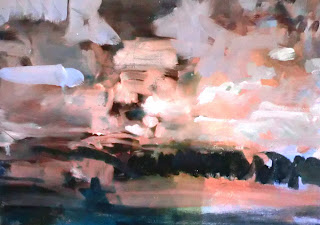
The "scent" (or in a more sophisticated sense, "sentiment") of truth in art is instinctive and intuitive. Here a brief sketch provides elements of a nautical scene without embellishment with color. The native artists' instinct for truth is alone his or her guide.

"Mt Pisgah"
In this painting, the pastel colors of Fall provide the poetics of seasonal change and the beauty of nature when contemplated spiritually and not thought of in a utilitarian manner. Nature in her grand manner is always deeper than any representation and yet even the cursory oil sketch, if done honestly and directly, will capture some of the depth and profundity of the scene.

"Mt Baldy"
Painting from high above the scene in "veduta" tradition gives emphasis to the vast horizen and distant mountains and we seem to float above the valley below that opens out to a vastness, an expanse that delights the eye.

"Amazon Park sketch"
Sometimes the "sentiment of/for truth" (verismo or il vero) demands complexity of form wherein the scene itself is very complex with overlapping forms and directional lines. Here a large park with its paths and distant hills provides the opportunity. But working "al aperto" (in the open air), one has to work quickly as the changing light first reveals and then conceals forms that exist only for as long as the light that falls upon them.

"Garibaldi"
In portraiture as well, the sentiment for truth demands simplification of form and an economy of work that provides for a statement revealing the personality and the importance of the sitter. This is especially evident from historical figures when working from fixed photos.

"Oregon Evening Veduta"
Sometimes when the sun goes down and color gets eclipsed, one can still reveal the truth of the scene in contrasts in value in the darker areas and also above, in the illuminated sky where forms provide a structure perhaps more important as the source of the diminishing light.
Axiom: Truth must be captured spontaneously in the moment when "everything-is-happening-at-once"
Some corollaries:
1. If the sentiment of truth is realized, a work is "finished" at the moment that tuth is captured, even in sketch mode.
2. Further embellishment, at this point, may actually diminish the truth value of the work although conventional wisdom, often wrongly, insists on covering all areas of the canvas.












































